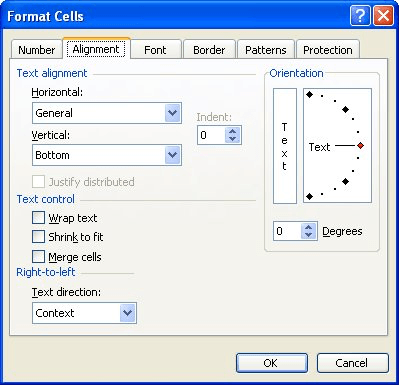Please Note: This article is written for users of the following Microsoft Excel versions: 97, 2000, 2002, and 2003. If you are using a later version (Excel 2007 or later), this tip may not work for you. For a version of this tip written specifically for later versions of Excel, click here: Adjusting Cell Margins for More White Space.
Written by Allen Wyatt (last updated September 7, 2024)
This tip applies to Excel 97, 2000, 2002, and 2003
Serena asked if there is a way to adjust the text margins with a cell so that there is more white space within a cell. The answer is that there is no intrinsic Excel command to add more space, as you can do in Word tables or with the CELLPADDING attribute in an HTML table. However, there is a way you can accomplish the desired goal, although it is somewhat more manual in nature. Follow these general steps:

Figure 1. The Alignment tab of the Format Cells dialog box.
The drawback to this approach, of course, is that it affects the width of not just one cell, but of the entire column and row. In addition, your numbers will not line up properly—on the decimal point—if you choose to center horizontally. The way around this last issue is to still center the contents horizontally, but use a custom number format for the cells, as follows:
[???,??0.00;-??,??0.00]
The question marks in the format forces Excel to leave space as if there were a digit, even if there isn't.
You cannot change the vertical white space without adjusting row height. There is, however, one thing you can try if you want to change the horizontal white space: Adjust the indent value used in a cell. All you need to do is display the Format Cells dialog box, and then set the indent on the Alignment tab. If you are using Excel 97 or 2000 you can only adjust the left indent. If you are using a later version of Excel you can adjust either the left or right indent (check out the Horizontal drop-down list), but not both.
ExcelTips is your source for cost-effective Microsoft Excel training. This tip (2762) applies to Microsoft Excel 97, 2000, 2002, and 2003. You can find a version of this tip for the ribbon interface of Excel (Excel 2007 and later) here: Adjusting Cell Margins for More White Space.

Solve Real Business Problems Master business modeling and analysis techniques with Excel and transform data into bottom-line results. This hands-on, scenario-focused guide shows you how to use the latest Excel tools to integrate data from multiple tables. Check out Microsoft Excel Data Analysis and Business Modeling today!
Creating custom formats is a very powerful way to display information exactly as you want it to appear. Most custom ...
Discover MoreFormatting a cell could, if you desire, also include the indentation of information within the cell. This tip examines ...
Discover MoreSometimes Excel does things that may appear just plain wacky. This particular tip deals with an issue that could crop up ...
Discover MoreFREE SERVICE: Get tips like this every week in ExcelTips, a free productivity newsletter. Enter your address and click "Subscribe."
There are currently no comments for this tip. (Be the first to leave your comment—just use the simple form above!)
Got a version of Excel that uses the menu interface (Excel 97, Excel 2000, Excel 2002, or Excel 2003)? This site is for you! If you use a later version of Excel, visit our ExcelTips site focusing on the ribbon interface.
FREE SERVICE: Get tips like this every week in ExcelTips, a free productivity newsletter. Enter your address and click "Subscribe."
Copyright © 2026 Sharon Parq Associates, Inc.
Comments